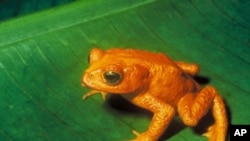Nearly 200 environmental ministers from around the world are meeting this week in Nagoya, Japan to adopt a new pact to protect wildlife, the source of food, medicines, industry and tourism.
Global ministers are seeking new goals on wildlife protection having fallen short of established benchmarks set for 2010.
In the remaining days of the conference, delegates are making a push for adoption of a 20-point plan, which sets new targets for 2020, aimed at getting governments and private industry to take sweeping actions to protect plant and animal species under assault by pollution, agricultural expansion, population growth and global warming.
Researchers hammered home the threat to global biodiversity in a new study issued to coincide with the conference.
The report, published this week in the journal Science, concludes that one-fifth of the world's vertebrates face extinction, according to Craig Hilton-Taylor of the environmental group International Union for Conservation of Nature, which maintains a list of endangered plant and animal species.
"The report is essentially the first global audit if you like of this group of organisms. And it very clearly shows we are not taking very good care of our natural capitol. Because the report shows that one in eight birds are threatened with extinction, one in seven of the bony fishes, one in four mammals, one in four reptiles threatened with extinction, one in three amphibians, one in three shark," Hilton-Taylor said.
The study includes data for 25,000 species on IUCN's Red List of Threatened Species.
According to the report, Southeast Asia has experienced the most dramatic losses in recent years, as a result agriculture, hardwood timber operations and unsustainable hunting.
Elsewhere, experts say the tropical rain forests of South America and Australia have also all experienced a dramatic loss of amphibians due to a deadly fungus.
But the threats to animal and plant life could have been a lot worse, says Ana Rodrigues of Center for Functional and Evolutionary Ecology in France. Rodrigues notes millions of dollars are spent every year on conservation efforts.
Without them, Rodrigues says the rate of decline of the world's vertebrates would have been nearly 20 percent greater. "The world is getting quite good at dealing with some types of threats," Rodrigues said. "For example, we are getting better and better at eradicating invasive species, invasive predators, from small islands."
The remaining days of the Conference on Biodiversity will focus on trying to smooth disagreements among countries over who should pay for biodiversity protection and how much.
Some developing nations say the current global funding of between $3 - $4 billion should be increased 100-fold.
Japan, meanwhile, has offered to give developing countries $2 billion to help meet 2020 goals.










